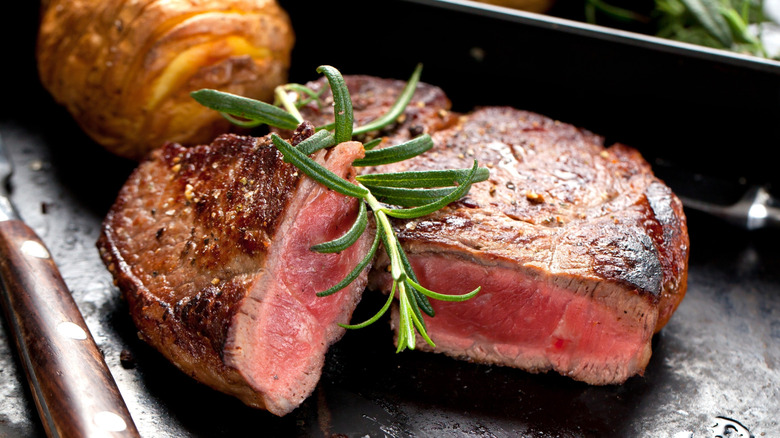What Is An Abscess In A Steak And Is It Safe To Eat The Meat?
If you brought a steak home and noticed an odd, pale lump within the meat, chances are it's not marbling but an abscess. Food Republic spoke to Dr. Crystal Heath, DVM and Executive Director at Our Honor, to learn more about what an abscess is and how it makes meat absolutely unsafe to eat.
Abscesses go far beyond a mistake you make when defrosting meat and are symptoms of improper cattle processing. "An abscess is a pocket of infection — a walled-off mass of pus made up of dead tissue, bacteria, and immune cells," explained Dr. Heath. Typically caused by high-grain "finishing" diets, they're a common injury cattle face, but Dr. Heath assured us that "federal inspectors are trained to identify and remove these lesions." However, if you've accidentally purchased a cut with an abscess, throw it out immediately. Symptoms of consuming such meat include nausea, fever, stomach pain, and other signs of gastrointestinal distress.
You should never attempt to remove an abscess from meat. "Even though cooking kills most bacteria, the tissue itself has undergone infection and decay, which changes its texture and chemistry," Dr. Heath said. "The U.S. Food Safety and Inspection Service classifies abscessed tissue as 'unwholesome' — it's not just unsightly, it's considered unfit for human consumption." Instead, the best way to avoid abscesses is to know what to look for and how to choose the perfect steak at the store.
How to avoid abscesses and pick a healthy steak
While rare, abscesses are fairly easy to pick out from healthy beef. They typically look like the yolk of a hard-boiled egg – off-white, round, and a bit squishy compared to muscle fibers and fat. Fortunately, they're most common on less popular cuts from the head, neck, and limbs rather than the torso.
If you can't tell if something is an abscess, cartilage, bone, or fat, follow the same criteria you'd use to tell if your steak has gone bad. Dr. Crystal Heath said, "Off smells, discoloration, or fluid pockets are always reasons to play it safe," and that healthy beef should be cherry-red. Since abscesses are essentially just pockets of bacteria and rotted flesh, the meat surrounding them may show signs of inflammation or decay, such as sliminess, brown-green coloring, and an off smell. If the beef's packaging looks swollen, Dr. Heath noted this could also be a sign of bacterial gas build-up, a sure sign of bad meat.
Though grass-fed beef's fat may have a yellowish tinge similar to an abscess, it shouldn't ever form in the same ball-like shape. Interstitial fat, the kind that forms between muscle fibers, typically looks like string-like striations through a cut of meat. Subcutaneous fat, the type most responsible for fat caps on cuts like ribeye, may be thick like an abscess, but should conform to the shape of the steak and never hang over or bulge around the muscle.


